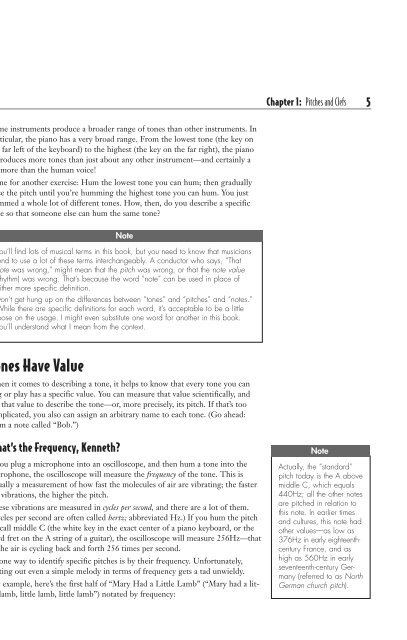The_Complete_Idiot%27s_Guide_To_Music_Theory
The_Complete_Idiot%27s_Guide_To_Music_Theory
The_Complete_Idiot%27s_Guide_To_Music_Theory
Create successful ePaper yourself
Turn your PDF publications into a flip-book with our unique Google optimized e-Paper software.
Some instruments produce a broader range of tones than other instruments. In<br />
particular, the piano has a very broad range. From the lowest tone (the key on<br />
the far left of the keyboard) to the highest (the key on the far right), the piano<br />
reproduces more tones than just about any other instrument—and certainly a<br />
lot more than the human voice!<br />
Time for another exercise: Hum the lowest tone you can hum; then gradually<br />
raise the pitch until you’re humming the highest tone you can hum. You just<br />
hummed a whole lot of different tones. How, then, do you describe a specific<br />
tone so that someone else can hum the same tone?<br />
Note<br />
You’ll find lots of musical terms in this book, but you need to know that musicians<br />
tend to use a lot of these terms interchangeably. A conductor who says, “That<br />
note was wrong,” might mean that the pitch was wrong, or that the note value<br />
(rhythm) was wrong. That’s because the word “note” can be used in place of<br />
either more specific definition.<br />
Don’t get hung up on the differences between “tones” and “pitches” and “notes.”<br />
While there are specific definitions for each word, it’s acceptable to be a little<br />
loose on the usage. I might even substitute one word for another in this book.<br />
You’ll understand what I mean from the context.<br />
<strong>To</strong>nes Have Value<br />
When it comes to describing a tone, it helps to know that every tone you can<br />
sing or play has a specific value. You can measure that value scientifically, and<br />
use that value to describe the tone—or, more precisely, its pitch. If that’s too<br />
complicated, you also can assign an arbitrary name to each tone. (Go ahead:<br />
Hum a note called “Bob.”)<br />
What’s the Frequency, Kenneth?<br />
If you plug a microphone into an oscilloscope, and then hum a tone into the<br />
microphone, the oscilloscope will measure the frequency of the tone. This is<br />
actually a measurement of how fast the molecules of air are vibrating; the faster<br />
the vibrations, the higher the pitch.<br />
<strong>The</strong>se vibrations are measured in cycles per second, and there are a lot of them.<br />
(Cycles per second are often called hertz; abbreviated Hz.) If you hum the pitch<br />
we call middle C (the white key in the exact center of a piano keyboard, or the<br />
third fret on the A string of a guitar), the oscilloscope will measure 256Hz—that<br />
is, the air is cycling back and forth 256 times per second.<br />
So one way to identify specific pitches is by their frequency. Unfortunately,<br />
writing out even a simple melody in terms of frequency gets a tad unwieldy.<br />
For example, here’s the first half of “Mary Had a Little Lamb” (“Mary had a little<br />
lamb, little lamb, little lamb”) notated by frequency:<br />
Chapter 1: Pitches and Clefs<br />
Note<br />
Actually, the “standard”<br />
pitch today is the A above<br />
middle C, which equals<br />
440Hz; all the other notes<br />
are pitched in relation to<br />
this note. In earlier times<br />
and cultures, this note had<br />
other values—as low as<br />
376Hz in early eighteenthcentury<br />
France, and as<br />
high as 560Hz in early<br />
seventeenth-century Germany<br />
(referred to as North<br />
German church pitch).<br />
5


